The Impact of Armed Conflict on Women and Girls - UNFPA
The Impact of Armed Conflict on Women and Girls - UNFPA
The Impact of Armed Conflict on Women and Girls - UNFPA
You also want an ePaper? Increase the reach of your titles
YUMPU automatically turns print PDFs into web optimized ePapers that Google loves.
Sexually Transmitted Infecti<strong>on</strong>s <strong>and</strong> HIV/AIDS. In developing countries,<br />
STIs <strong>and</strong> their complicati<strong>on</strong>s rank in the top five disease categories for which<br />
adults seek health care. In women <str<strong>on</strong>g>of</str<strong>on</strong>g> childbearing age, STIs, excluding<br />
HIV/AIDS, are the sec<strong>on</strong>d highest cause <str<strong>on</strong>g>of</str<strong>on</strong>g> death <strong>and</strong> disability after maternal<br />
causes.<br />
STIs, including HIV/AIDS, spread fastest where there is poverty,<br />
powerlessness <strong>and</strong> social instability. <str<strong>on</strong>g>The</str<strong>on</strong>g>se c<strong>on</strong>diti<strong>on</strong>s are characteristic <str<strong>on</strong>g>of</str<strong>on</strong>g> life in<br />
refugee settings. As a c<strong>on</strong>sequence, there is an increasing incidence <str<strong>on</strong>g>of</str<strong>on</strong>g> STIs <strong>and</strong><br />
HIV am<strong>on</strong>g displaced populati<strong>on</strong>s. War-affected populati<strong>on</strong>s are<br />
disproporti<strong>on</strong>ately at risk for STIs, including HIV. During flight, refugees are<br />
exposed to populati<strong>on</strong>s with differing levels <str<strong>on</strong>g>of</str<strong>on</strong>g> HIV infecti<strong>on</strong>. Displacement<br />
promotes transmissi<strong>on</strong> between high- <strong>and</strong> low-prevalence groups as well as<br />
exposure to the military, which further promotes transmissi<strong>on</strong>.<br />
Even in peacetime, soldiers have STI infecti<strong>on</strong> rates two to five times<br />
higher than those <str<strong>on</strong>g>of</str<strong>on</strong>g> civilian populati<strong>on</strong>s. During armed c<strong>on</strong>flict, their rates can be<br />
up to 50 times higher. 4 In many countries, rates <str<strong>on</strong>g>of</str<strong>on</strong>g> HIV infecti<strong>on</strong> are c<strong>on</strong>siderably<br />
higher am<strong>on</strong>g military pers<strong>on</strong>nel than am<strong>on</strong>g the general populati<strong>on</strong>. <str<strong>on</strong>g>The</str<strong>on</strong>g><br />
possibility <str<strong>on</strong>g>of</str<strong>on</strong>g> death in combat may serve to distance men from the more remotely<br />
perceived threat <str<strong>on</strong>g>of</str<strong>on</strong>g> HIV infecti<strong>on</strong>. 5<br />
Although some work is being d<strong>on</strong>e with United Nati<strong>on</strong>s <strong>and</strong> other armed<br />
forces, more needs to be d<strong>on</strong>e to educate the military about safe sex <strong>and</strong> the<br />
spread <str<strong>on</strong>g>of</str<strong>on</strong>g> HIV/AIDS. Many <str<strong>on</strong>g>of</str<strong>on</strong>g> the internati<strong>on</strong>al forces come themselves from<br />
areas with high HIV prevalence. <str<strong>on</strong>g>The</str<strong>on</strong>g>ir c<strong>on</strong>tributi<strong>on</strong> to the spread <str<strong>on</strong>g>of</str<strong>on</strong>g> the disease<br />
should not be underestimated.<br />
However, interventi<strong>on</strong>s should not stop with the military. Behaviour<br />
change projects need to target all men, including adolescents <strong>and</strong> boys.<br />
For physiological reas<strong>on</strong>s, women are more likely than men to be infected<br />
through heterosexual c<strong>on</strong>tact. Aggravating this physiological vulnerability is the<br />
discriminati<strong>on</strong> many women face in the ec<strong>on</strong>omic, social, civil <strong>and</strong> political<br />
spheres. <str<strong>on</strong>g>The</str<strong>on</strong>g> Beijing Platform for Acti<strong>on</strong> <strong>and</strong> the ICPD Programme <str<strong>on</strong>g>of</str<strong>on</strong>g> Acti<strong>on</strong><br />
recognize that women’s social discriminati<strong>on</strong> <strong>and</strong> unequal power relati<strong>on</strong>s with<br />
respect to men are key determinants in their vulnerability to HIV/AIDS. In c<strong>on</strong>flict<br />
settings, this vulnerability increases.<br />
One area <str<strong>on</strong>g>of</str<strong>on</strong>g> reproductive health in refugee situati<strong>on</strong>s needing more<br />
research is the impact <strong>on</strong> sexual behaviour <str<strong>on</strong>g>of</str<strong>on</strong>g> post-genocide/c<strong>on</strong>flict fatalism<br />
4 Joint United Nati<strong>on</strong>s Programme <strong>on</strong> HIV/AIDS, AIDS <strong>and</strong> the military (Geneva, UNAIDS, May<br />
1998).<br />
5 K. Gord<strong>on</strong> <strong>and</strong> K. Crehan, Dying <str<strong>on</strong>g>of</str<strong>on</strong>g> Sadness: Gender, Sexual Violence <strong>and</strong> the HIV Epidemic<br />
(New York, United Nati<strong>on</strong>s Development Programme, 2000).<br />
53



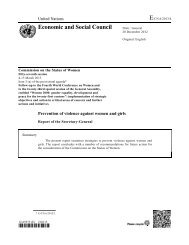
![IANSA [PDF, 2MB] - PeaceWomen](https://img.yumpu.com/25206379/1/190x123/iansa-pdf-2mb-peacewomen.jpg?quality=85)
![Commitments Sample [PDF, 93KB] - PeaceWomen](https://img.yumpu.com/25206331/1/190x245/commitments-sample-pdf-93kb-peacewomen.jpg?quality=85)


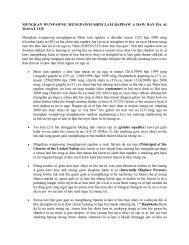
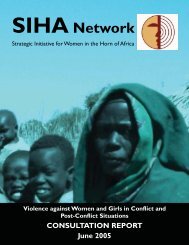



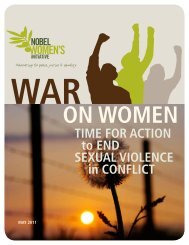
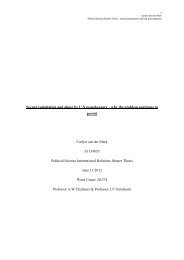

![A Toolkit for Advocacy and Action [PDF, 260KB] - Peace Women](https://img.yumpu.com/25205989/1/190x245/a-toolkit-for-advocacy-and-action-pdf-260kb-peace-women.jpg?quality=85)